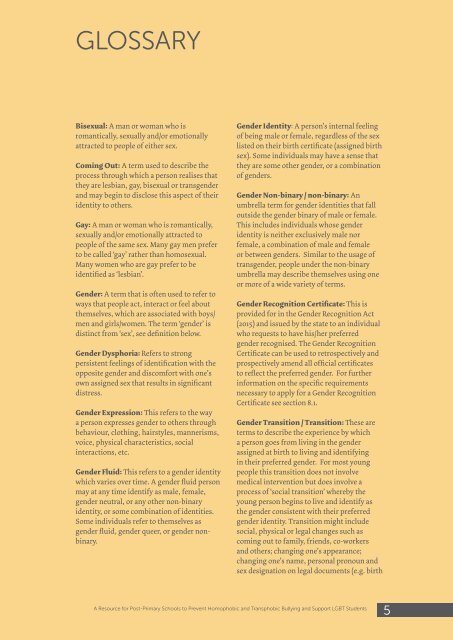‘BEING LGBT IN SCHOOL’
GLEN__Being_LGBT_in_School_10_Feb_2016_Web_3
GLEN__Being_LGBT_in_School_10_Feb_2016_Web_3
You also want an ePaper? Increase the reach of your titles
YUMPU automatically turns print PDFs into web optimized ePapers that Google loves.
GLOSSARY<br />
Bisexual: A man or woman who is<br />
romantically, sexually and/or emotionally<br />
attracted to people of either sex.<br />
Coming Out: A term used to describe the<br />
process through which a person realises that<br />
they are lesbian, gay, bisexual or transgender<br />
and may begin to disclose this aspect of their<br />
identity to others.<br />
Gay: A man or woman who is romantically,<br />
sexually and/or emotionally attracted to<br />
people of the same sex. Many gay men prefer<br />
to be called ‘gay’ rather than homosexual.<br />
Many women who are gay prefer to be<br />
identified as ‘lesbian’.<br />
Gender: A term that is often used to refer to<br />
ways that people act, interact or feel about<br />
themselves, which are associated with boys/<br />
men and girls/women. The term ‘gender’ is<br />
distinct from ‘sex’, see definition below.<br />
Gender Dysphoria: Refers to strong<br />
persistent feelings of identification with the<br />
opposite gender and discomfort with one’s<br />
own assigned sex that results in significant<br />
distress.<br />
Gender Expression: This refers to the way<br />
a person expresses gender to others through<br />
behaviour, clothing, hairstyles, mannerisms,<br />
voice, physical characteristics, social<br />
interactions, etc.<br />
Gender Fluid: This refers to a gender identity<br />
which varies over time. A gender fluid person<br />
may at any time identify as male, female,<br />
gender neutral, or any other non-binary<br />
identity, or some combination of identities.<br />
Some individuals refer to themselves as<br />
gender fluid, gender queer, or gender nonbinary.<br />
Gender Identity: A person’s internal feeling<br />
of being male or female, regardless of the sex<br />
listed on their birth certificate (assigned birth<br />
sex). Some individuals may have a sense that<br />
they are some other gender, or a combination<br />
of genders.<br />
Gender Non-binary / non-binary: An<br />
umbrella term for gender identities that fall<br />
outside the gender binary of male or female.<br />
This includes individuals whose gender<br />
identity is neither exclusively male nor<br />
female, a combination of male and female<br />
or between genders. Similar to the usage of<br />
transgender, people under the non-binary<br />
umbrella may describe themselves using one<br />
or more of a wide variety of terms.<br />
Gender Recognition Certificate: This is<br />
provided for in the Gender Recognition Act<br />
(2015) and issued by the state to an individual<br />
who requests to have his/her preferred<br />
gender recognised. The Gender Recognition<br />
Certificate can be used to retrospectively and<br />
prospectively amend all official certificates<br />
to reflect the preferred gender. For further<br />
information on the specific requirements<br />
necessary to apply for a Gender Recognition<br />
Certificate see section 8.1.<br />
Gender Transition / Transition: These are<br />
terms to describe the experience by which<br />
a person goes from living in the gender<br />
assigned at birth to living and identifying<br />
in their preferred gender. For most young<br />
people this transition does not involve<br />
medical intervention but does involve a<br />
process of ‘social transition’ whereby the<br />
young person begins to live and identify as<br />
the gender consistent with their preferred<br />
gender identity. Transition might include<br />
social, physical or legal changes such as<br />
coming out to family, friends, co-workers<br />
and others; changing one’s appearance;<br />
changing one’s name, personal pronoun and<br />
sex designation on legal documents (e.g. birth<br />
A Resource for Post-Primary Schools to Prevent Homophobic and Transphobic Bullying and Support <strong>LGBT</strong> Students<br />
5


